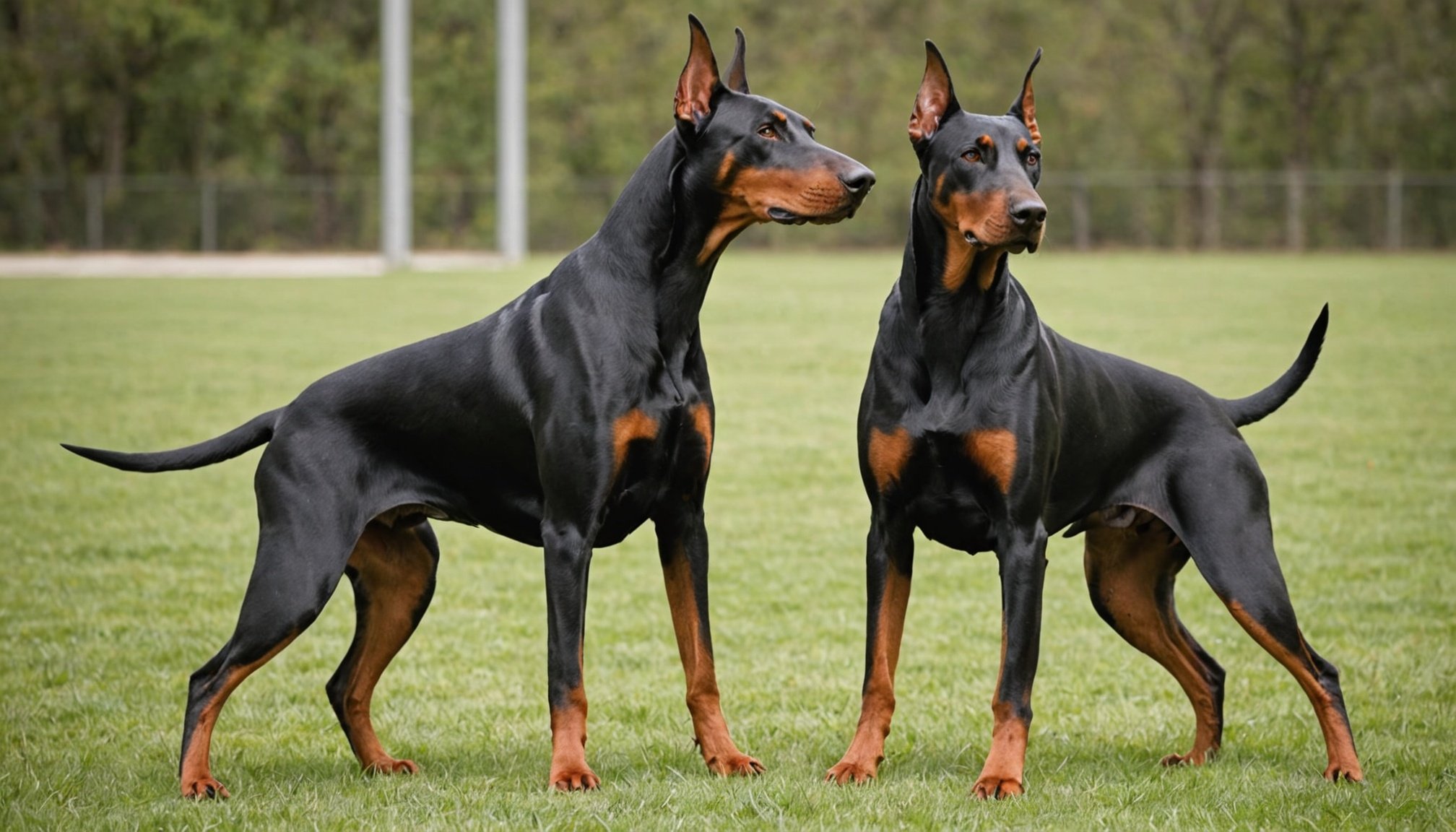Understanding the Doberman Pinscher Temperament
The Doberman Pinscher is renowned for its intelligent and loyal temperament, which significantly influences its behaviour. Training this breed requires an understanding of certain key characteristics inherent in Doberman temperament. These dogs are highly intelligent, which makes them quick learners but also means they can become easily bored if not mentally engaged. Due to their protective instincts, a Doberman needs consistent training starting from a young age to harness their potential.
Socialisation plays a critical role in shaping Doberman behaviour. By exposing them to a variety of environments, people, and other animals early on, one can foster a well-adjusted adult dog. It aids in reducing any potential aggression and enhances their ability to remain calm in unfamiliar situations. Socialisation ensures that their innate watchfulness doesn’t turn into undue shyness or fearfulness.
In parallel : Ultimate nutrition blueprint for senior bulldogs: boosting health and mobility with the right diet
The obedience potential of a Doberman is strongly influenced by its temperament. With consistent training and proper socialisation, they can become obedient companions. Patience and positive reinforcement techniques work best, given their strong-willed nature. Understanding and working with their natural traits can lead to a rewarding relationship with this energetic breed.
Essential Training Techniques for Obedience
Understanding the fundamentals of obedience training is crucial for effective pet behavior management. Start with positive reinforcement methods, like offering treats or praise, to reward pets for good behavior. This strategy helps reinforce desired actions by creating positive associations. Consistency, however, holds equal importance. Always use the same commands and cues to avoid confusing your pet. Inconsistent language can hinder a pet’s ability to learn reliably.
Have you seen this : Anticiper le coup de chaleur : guide pour identifier les signes chez votre bouledogue français
Timing plays a pivotal role in training success. Deliver rewards or corrections immediately after the behavior to ensure the pet links the response with their action. Delayed responses might confuse the animal, resulting in inefficient learning. Patience is also essential. Like humans, pets require time to absorb and understand commands completely. Persistence without frustration will yield the best results.
Training sessions should remain short and engaging. Overloading animals with too many commands can lead to fatigue and disinterest. Instead, allow ample time for repetition and practice, embedding learned behaviors effectively. Combining these essential training techniques fosters a well-behaved, obedient pet, enhancing the human-animal bond. By focusing on strategies that emphasize reinforcement, consistency, and patience, pet owners will see fruitful outcomes.
Step-by-Step Obedience Training Exercises
Training a dog requires patience and consistency. By integrating obedience exercises into your routine, you’ll gradually build a well-behaved companion. Here’s how to navigate through essential training exercises:
Basic Commands
Begin with fundamental commands such as sit, stay, down, and come. These form the foundation of good behaviour. Introduce your leash gradually, encouraging comfort and control. This tool is vital for building command duration and reliability. For instance, while teaching “stay,” gradually increase the time and distance before rewarding compliance. This solidifies their understanding, ensuring commands aren’t just temporary tricks but steady behaviours.
Advanced Obedience Skills
After mastering basic commands, advance to skills like distance stays and recalls. Commands such as “heel” or “place” demand more precision and patience. Start in a distraction-free environment to ensure comprehension, then slowly incorporate distractions. This simulates real-world situations, fostering focus even amidst chaos.
Real-Life Situational Training
Training shouldn’t happen in isolation. Practice obedience exercises amidst daily activities. Walks are perfect for reinforcing commands like “heel” or “stay,” as they naturally present a plethora of distractions. Use scenarios like meal times as opportunities to practice “sit” or “wait,” making each lesson an intrinsic part of their routine.
Overcoming Common Training Challenges
Training Dobermans can be a rewarding experience, yet it comes with its share of training challenges. Distractions are a prevalent hurdle during dog training sessions. Ensuring a conducive environment with minimal interruptions is critical for effective learning. Identify potential distractions—such as noise or other animals—and develop strategies to minimize their impact.
Dobermans, known for their intelligence and alertness, can exhibit certain behavioral issues. Jumping on people, excessive barking, and pulling on the leash are common behaviors that need correction. The first step in addressing these is understanding the root cause. It might be excitement, anxiety, or a desire for attention.
Here are some strategies for correcting unwanted behaviors:
- Consistent commands: Using the same keywords every time ensures the dog understands expectations.
- Positive reinforcement: Reward desirable behaviors with treats or praise. This encourages repetition.
- Redirection: Guide your Doberman to a preferred behavior when unwanted actions arise, maintaining patience and consistency.
By foreseeing and addressing these training challenges, you pave the way for a well-behaved and happy Doberman. Understanding and patience are key components in shaping their behavior effectively.
Preparing for Obedience Competitions
Understanding competition requirements and managing preparation are essential steps in embarking on a successful journey in obedience competitions.
Understanding Competition Requirements
Key elements of obedience competitions must be considered. Familiarization with the competition environment allows handlers and their Dobermans to better navigate the setting. Reviewing rules and regulations specific to events ensures compliance and boosts competitive edge. Each event may have distinct guidelines, so thorough preparation is crucial.
Building a Training Schedule for Competitions
Creating a timeline leading up to events is vital for effective competition preparation. Incorporating practice sessions and break periods maintains mental and physical conditioning, crucial for both handler and Doberman. A strategically structured schedule optimizes training efforts and ensures readiness for competition day.
Techniques for Maintaining Calmness in the Ring
Strategies for managing handler anxiety are key in ensuring stable performance. Keeping the Doberman focused during performance can significantly influence competition results. Conducting mock trials introduces the team to real competition conditions, aiding focus and composure. Engaging in these techniques ensures both the handler and Doberman are poised and prepared for the challenges of the ring.
Insights into the Unique Characteristics of Doberman Pinschers
The intelligence of the Doberman Pinscher plays a crucial role in its trainability. These dogs possess a remarkable aptitude for learning commands and tasks, often excelling in obedience training. Their ability to quickly assimilate information makes them stand out among other breeds, especially when breed-specific training methods are employed.
Understanding the physical attributes of the Doberman is also key to optimizing training sessions. With a sleek, muscular build, they are naturally predisposed to agility and endurance. These physical traits can be harnessed through activities that require quick reflexes and sustained physical engagement, such as agility courses and tracking exercises. Training should, therefore, incorporate activities that challenge both their mind and body.
Additionally, appreciating the Doberman’s historical background can enhance training strategies. Originally bred for personal protection and work, they possess a strong protective instinct and a deep bond with their families. Effective training strategies can incorporate this by reinforcing positive guard and protection behaviors, coupled with socialization to balance their innate instincts. Recognizing these unique Doberman characteristics enables owners to foster a well-rounded, obedient companion.
Obedience Training Fundamentals
Training a Doberman Pinscher in basic commands is crucial for fostering a well-behaved companion. Establishing obedience ensures your pet listens to essential commands like “sit,” “stay,” and “come.” Such commands aren’t just about compliance but are key to maintaining safety and harmony in diverse environments.
Recommended Training Timeline and Milestones
A structured timeline is pivotal. Start obedience training as early as possible, ideally when the puppy is around 8 weeks old. At this initial stage, focus on simple commands and positive reinforcement techniques. By 6 months, your Doberman should consistently respond to foundational commands. Gradual progression allows for a steady learning pace, reinforcing each achievement before moving on to more advanced Doberman training techniques.
Techniques for Maintaining Focus During Training
Maintaining a Doberman’s focus can be challenging, as they’re known for their energetic nature. Short, focused sessions work best. Aim for 5-10 minutes of training, multiple times a day. Incorporate toys and treats to capture attention, ensuring practice occurs in a distraction-free setting. Always use a consistent tone and clear hand signals. This helps your Doberman associate commands with desired behaviours, creating a strong foundation for lifelong obedience.
Advanced Training Techniques
Training a Doberman Pinscher requires discipline, patience, and the right approach. Mastering advanced dog training techniques begins with tackling behavior modification. It’s critical to establish basic obedience before progressing to complex commands and tricks. This involves using strategies such as positive reinforcement and clicker training, ensuring the dog understands what’s expected in a rewarding manner.
Positive reinforcement is key: reward desired behavior immediately after it occurs, using treats, praise, or play as motivation. The correct timing solidifies command execution in the dog’s mind. Clicker training involves using a distinct sound to mark correct behavior, bridging the action and reward gap. This method improves precision and helps the dog learn multi-step tasks, such as retrieving specific items or performing agility sequences.
Addressing behavioral issues unique to Dobermans, like excessive barking or guarding instincts, requires consistency. Positive reinforcement can encourage calm behavior in stimulus-heavy environments. Patience is crucial—acknowledge small progress to avoid frustration. For competition skills, break down advanced tasks into manageable pieces and reward each milestone.
Engaging and challenging a Doberman with advanced training not only hones their skills but also strengthens the bond between trainer and dog.
Creating Effective Practice Routines
Establishing structured daily training sessions is crucial for maximising effectiveness. Practice schedules should start with simple commands before gradually involving more complex tasks, permitting both the trainer and the dog to build confidence and understanding. The key is to incorporate an element of fun in each session to maintain the Doberman’s interest. You might wonder: How can I incorporate variety to keep my Doberman engaged? By creatively altering the training environment or introducing new commands each week, you can effectively maintain the dog’s attention and eagerness.
Ensuring consistency in dog training will significantly impact the dog’s ability to learn. It is advisable to maintain a predictable routine, but always leave some room for spontaneous play, which keeps the learning experience enjoyable.
Determining the optimal practice schedule is vital. Training sessions should be between 10 to 15 minutes, as longer durations might lead to cognitive fatigue. Consider timing your sessions when your Doberman is most alert, such as after a brief walk. Balancing consistency with variety ensures that routines remain effective and beneficial over time.
Preparation for Competitions
Embarking on the journey of competition training with your Doberman is both a rewarding and strategic endeavour. To enhance your Doberman’s competition readiness, it is crucial to understand and strategise effectively.
Understanding Competition Requirements
Each competition may have distinct requirements that necessitate tailored performance strategies. Knowing the specific skills judged, such as agility or obedience, is fundamental. It helps in setting clear training goals aligned with these criteria, optimising preparation, and reducing unexpected challenges during actual events.
Building a Training Support Team
Creating an effective training support team is imperative. This team may include experienced trainers, handlers, and even veterinarians. Such partnerships can offer expertise, ensure your Doberman’s health, and refine techniques, contributing substantially to your dog’s development and success.
Simulation of Competition Environments
To further competition readiness, simulate real-world scenarios. Construct environments mimicking competition settings, complete with distractions, to acclimate your Doberman. This practice builds confidence, diminishing anxiety, and improving performance on the day of the event.
By focusing on these strategies, you’ll lay a solid foundation for success in any Doberman competition, ensuring both you and your canine companion are well-prepared and poised for victory.
Identifying and Overcoming Common Challenges
Training Dobermans can present certain challenges that require careful attention and strategic approaches. One prevalent issue is the propensity for these intelligent dogs to encounter distractions. To overcome such behavioral issues, it is advisable to conduct training sessions in environments with minimal distractions and to gradually introduce new stimuli as your Doberman progresses. This can help improve focus and enhance learning outcomes.
Another common pitfall is inconsistency in training. Consistency is key to successfully addressing behavioral issues. Make sure that all family members involved in the training process use the same commands and reward systems.
Troubleshooting techniques are instrumental in assessing progress and adapting training methods. Observing your Doberman’s responses can provide valuable insights into their learning patterns. If a particular technique isn’t effective, don’t hesitate to adjust your methods. For instance, if verbal commands aren’t sufficiently grabbing attention, incorporate clear hand signals.
Regularly monitoring behavior and milestones ensures a well-rounded training experience. By staying attuned to your Doberman’s development, you can better customize the training regimen to suit their specific needs, ultimately fostering a more harmonious relationship.
Expert Insights and Success Stories
In the realm of Doberman dog training and competition, expert opinions play a crucial role in guiding new trainers. Interviews with seasoned trainers reveal insights derived from years of dedication. They stress the importance of consistency and patience, particularly when working with these intelligent and energetic dogs.
Successful competitors in dog sports often share similar training experiences. They emphasise the significance of starting training early in a Doberman’s life, adapting training methods to suit individual personalities, and incorporating positive reinforcement techniques. This approach has led many trainers to achieve substantial success in dog competitions, highlighting the breed’s potential.
Case studies offer further evidence of success in this field. One notable example involves a Doberman named Max, who overcame early behavioural challenges to become a champion in obedience trials. His trainer credits their success to a structured training routine that balanced discipline with ample fulfilment. These stories showcase how commitment and a tailored approach can yield impressive results.
Reflecting on these journeys, many trainers agree on crucial lessons. Understanding a Doberman’s unique temperament and needs can significantly enhance training outcomes. Moreover, embracing flexibility and creativity in training regimes often distinguishes average competitors from champions.
Enhancing Engagement with Visual Aids
Visual aids, such as dog training visuals, play a pivotal role in improving the effectiveness of training. They include instructional videos and clear diagrams that provide clarity on techniques. By showing tricks visually, dogs and their owners can understand and remember the process better.
A very effective type of visual aid is instructional videos. They can demonstrate a step-by-step approach, capturing nuances that might be missed in text descriptions. These videos can be paused and replayed until both the trainer and the dog grasp the instructions. Diagrams for training are another valuable tool. They capture the sequence of steps, making it easier for trainers to follow along.
Creating DIY training guides is an accessible way to incorporate dog training visuals. By using images and videos, trainers can personalize the experience to the specific needs of their dogs.
Utilizing technology for progress tracking is another key aspect. Apps designed for dog training can help monitor progress and provide feedback when integrating visuals. By leveraging these technological advancements, trainers can efficiently adjust methods and ensure a structured development process.











